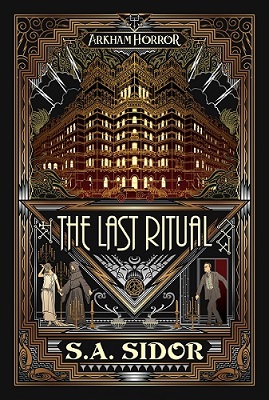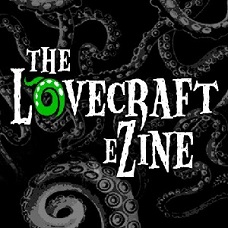 I greatly enjoyed Pete Rawlik’s Reanimators. That novel followed Dr. Stuart Hartwell as he attempted to perfect his re-agent, a serum to cure death, while competing with H.P. Lovecraft’s Herbert West. Hartwell’s adventures gave readers new perspectives from which to view some of Lovecraft’s work. For instance, Hartwell plays a small part in the creation of the titular Dunwich Horror. I talked about my enjoyment of Reanimators in my Summer Reading Roundup last year, but now I’m ready to discuss the sequel, The Weird Company: The Secret History of H.P. Lovecraft’s Twentieth Century.
I greatly enjoyed Pete Rawlik’s Reanimators. That novel followed Dr. Stuart Hartwell as he attempted to perfect his re-agent, a serum to cure death, while competing with H.P. Lovecraft’s Herbert West. Hartwell’s adventures gave readers new perspectives from which to view some of Lovecraft’s work. For instance, Hartwell plays a small part in the creation of the titular Dunwich Horror. I talked about my enjoyment of Reanimators in my Summer Reading Roundup last year, but now I’m ready to discuss the sequel, The Weird Company: The Secret History of H.P. Lovecraft’s Twentieth Century.
I should think it goes without saying, but if you want to truly enjoy Reanimators and The Weird Company, you’ll need to be familiar with the works of H.P. Lovecraft. Whereas Reanimators primarily drew on Lovecraft’s schlocky Frankenstein tale, Reanimator, The Weird Company takes most of its major inspiration from At the Mountains of Madness. Rawlik doesn’t just draw from At the Mountains of Madness though. Characters and references from The Shadow Over Innsmouth, The Thing on the Doorstep, Dreams in the Witch House, The Hounds of Tindalos, The Blob, John Carpenter’s The Fog, The Dream Quest of Unknown Kadath, Through the Gates of the Silver Key, and The Strange High House in the Mist appear within the pages of the Weird Company. And those are just the characters and references I identified, and remembered, while writing my review.
Minor Spoilers Below
In The Weird Company, Shoggoths, protoplasmic monsters, are working to abscond from their icy solitude in Antarctica. Their escape from the frozen continent will spell doom for humanity. The only force standing in the Shoggoths’ path is the Weird Company, a group of unlikely heroes who I think of as The League of Extraordinary Gentlemen if Alan Moore drew from Lovecraft stories instead of classic fiction. The narrative is relayed via diary entries from several members of the Weird Company, mostly from Robert Olmstead, the protagonist from The Shadow Over Innsmouth. Together the group travels to Antarctica and battles to keep the Shoggoths from escaping.
Rawlik adds several new twists and connections into Lovecraft’s existing canon. Some purists might be skeptical of these, but I liked all of the fresh inclusions. One fascinating link Rawlik makes is between the blood of the Elder Things, creatures from At the Mountains of Madness, and the re-agent created by Herbert West and Dr. Stuart Hartwell. The Elder Things can enter stasis and effectively live forever, and the re-agent preserves and revives, so it makes sense the two substances would be similar. Rawlik also manages to make the Elder Things rather terrifying in their locomotion, a feat infinitely impressive considering Lovecraft’s original descriptions of their alien forms. At the end of the book, there’s also a ghoulish twist to the Elder Sign, which is traditionally portrayed as a protective ward.
My review is quickly devolving into a lunatic’s raving, and I’d prefer to avoid being committed to the Arkham Sanitarium, but I have a few last thoughts before I end. The climax of the story is a ton of fun, if like me, you’re a fan of cats, specifically The Cats of Ulthar. Oliver Wyman does an outstanding job narrating The Weird Company on Audible. He did the same for Reanimators. Lastly, don’t forget to check out Pete Rawlik’s latest Lovecraftian installment, The Miskatonic University Spiritualism Club. The book is now available for pre-order from Jackanapes Press.
Read more of my work
View all my Goodreads reviews
 Lovecraft’s Cthulhu Mythos. Campbell’s first book, The Inhabitant of the Lake, was published by Arkham House, the small press that is primarily responsible for the survival of H.P. Lovecraft’s fiction. Campbell also corresponded with Arkham House’s founder, August Derleth. Fans of the Cthulhu Mythos will know the significance of mythos writers corresponding. Lovecraft was a prodigious writer of letters, and he had a vast circle of literary acquaintances when he passed away. Derleth was among Lovecraft’s correspondents. This creates a direct link from Lovecraft to Campbell through Derleth. All of which is to say Campbell has a pedigree in the horror writing community. Despite that, I hadn’t read his work due to the daunting amount he has written in his lifetime. Quite frankly, I just didn’t know where to start. Thankfully, Eric J. Guignard solved that problem for me with his publication of A Primer to Ramsey Campbell. This collection of six of Campbell’s tales is a perfect entry into his work. Each story has a fantastic analysis by Michael Arnzen, PhD, which lends the reader additional insight into each work. I can’t say enough good things about this compact book. Do yourself a favor and order a copy. Even if you’re familiar with all of Campbell’s work, Arnzen’s analysis will make re-reading previously published tales worth the purchase price.
Lovecraft’s Cthulhu Mythos. Campbell’s first book, The Inhabitant of the Lake, was published by Arkham House, the small press that is primarily responsible for the survival of H.P. Lovecraft’s fiction. Campbell also corresponded with Arkham House’s founder, August Derleth. Fans of the Cthulhu Mythos will know the significance of mythos writers corresponding. Lovecraft was a prodigious writer of letters, and he had a vast circle of literary acquaintances when he passed away. Derleth was among Lovecraft’s correspondents. This creates a direct link from Lovecraft to Campbell through Derleth. All of which is to say Campbell has a pedigree in the horror writing community. Despite that, I hadn’t read his work due to the daunting amount he has written in his lifetime. Quite frankly, I just didn’t know where to start. Thankfully, Eric J. Guignard solved that problem for me with his publication of A Primer to Ramsey Campbell. This collection of six of Campbell’s tales is a perfect entry into his work. Each story has a fantastic analysis by Michael Arnzen, PhD, which lends the reader additional insight into each work. I can’t say enough good things about this compact book. Do yourself a favor and order a copy. Even if you’re familiar with all of Campbell’s work, Arnzen’s analysis will make re-reading previously published tales worth the purchase price.



 I greatly enjoyed Pete Rawlik’s Reanimators. That novel followed Dr. Stuart Hartwell as he attempted to perfect his re-agent, a serum to cure death, while competing with H.P. Lovecraft’s Herbert West. Hartwell’s adventures gave readers new perspectives from which to view some of Lovecraft’s work. For instance, Hartwell plays a small part in the creation of the titular Dunwich Horror. I talked about my enjoyment of Reanimators in my
I greatly enjoyed Pete Rawlik’s Reanimators. That novel followed Dr. Stuart Hartwell as he attempted to perfect his re-agent, a serum to cure death, while competing with H.P. Lovecraft’s Herbert West. Hartwell’s adventures gave readers new perspectives from which to view some of Lovecraft’s work. For instance, Hartwell plays a small part in the creation of the titular Dunwich Horror. I talked about my enjoyment of Reanimators in my  I was initially interested in The Last Ritual for two reasons. First, it was set in the Arkham Horror Universe. Anyone who knows me is aware I’m obsessed with Fantasy Flight’s Arkham Horror games. I most recently discussed my love for these games when I unboxed two recent products in a
I was initially interested in The Last Ritual for two reasons. First, it was set in the Arkham Horror Universe. Anyone who knows me is aware I’m obsessed with Fantasy Flight’s Arkham Horror games. I most recently discussed my love for these games when I unboxed two recent products in a 




